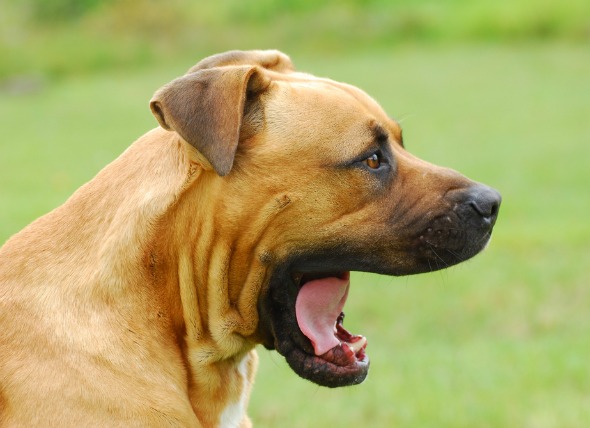

Ehrlichiosis in dogs is a rickettsia infection caused by the organisms Ehrlichia canis and Ehrlichia lewinii. These bacteria are spread by the brown dog tick and the Lone Star tick, respectively. Rickettsiae are a type of bacteria that inhabit a cell, in this case, the body's white blood cells, which are destroyed in the process.
While there are a number of species in the genus Ehrlichia, the E. canis and E. lewinii are the two that are of main concern for dogs, with E. canis being the more diagnosed form (note that these bacteria can infect other animals as well, including humans). This disease is seen throughout the year and throughout the continental U.S., but is more common on the Gulf Coast, eastern seaboard, Southwest and California, geographical areas that tend to have an abundance of warm days. Chronic and severe forms of this disease are more representative in Doberman pinschers and German shepherds.
There are three stages of Ehrlichiosis:
Acute stage:
Subclinical stage:
Chronic Stage:
You will need to provide a thorough history of your dog's health leading up to the onset of symptoms, including recent activities, and the environment your dog spends time in. It goes without saying that if your dog has recently been bitten by a tick, you will need to share this information with your veterinarian.
Along with the standard fluid tests, complete blood count (CBC), biochemistry profile, and urinalysis, your veterinarian will also need to carry out more specific tests for isolating E. canis. Polymerase Chain Reaction (PCR) testing, which isolates the DNA of the causative agent, is now commonly employed for confirmation. The PCR test, in combination with a test for antibodies to the Ehrlichia infection, is typically the best way to make a concrete diagnosis.
Typically, ehrlichiosis will cause a decreased number of platelets (the cells involved in the clotting of blood), a condition referred to as thrombocytopenia. There will also be a decreased number of neutrophils (a type of white blood cell), anemia, and an increased number of lymphocytes (a type of white blood cell usually seen in advanced infections). The urinalysis may reveal the presence of proteins in urine, which result from inflammation of the kidneys.
Other indications your veterinarian will look for are hemorrhages within the retina of the eye, inflammation of the lungs, an enlarged spleen, and inflammation of the brain or spinal cord. If nervous symptoms are present, such as a lack of coordination or seizures, your veterinarian may take a sample of cerebrospinal fluid (CSF) for further evaluation.
The main objective of treatment is to clear the body of the organism and stabilize the patient by managing complications like anemia and bleeding related to this disease. Standard antibiotic therapy remains the choice for treatment, along with anti-inflammatory drugs for reducing swelling and inflammation.
Your veterinarian will also treat your dog with fluid therapy to maintain the water content, and if anemia is severe, a blood transfusion may also be required. Other drugs and therapies will be chosen based on the stage of illness your dog is experiencing. Prognosis is best when treatment is begun early.
Observe your dog closely and immediately call your veterinarian if your dog begins to bleed from any site. It is recommended that you provide a calm and quiet space where your dog can rest until fully recovered. Physical activity should be low impact, with short walk outdoors. Avoid areas where ticks may be present as much as possible.
Most dogs recover well with prompt and appropriate therapy. Some dogs clinically recover but the infection is not entirely eradicated, remaining in the body and sometimes returning at a later time. Your veterinarian will repeat blood tests during follow-up examinations to determine your dog's progress. Medications may be changed according to your dog's progress.
Ehrlichiosis is a common infection, and one to be on guard against in almost all geographical locations, and throughout the year. The best preventative is to practice tick control using tick resistant products on your dog, and checking your dog's skin and fur daily for the presence of ticks. Consult your veterinarian for proper guidelines on tick control in your specific area.
 Antifreeze Poisoning in Dogs
Ethylene Glycol Poisoning in Dogs
Ethylene glycol
Antifreeze Poisoning in Dogs
Ethylene Glycol Poisoning in Dogs
Ethylene glycol
 Hearing Loss in Dogs
Deafness in Dogs
Deafness refers to the lack (or
Hearing Loss in Dogs
Deafness in Dogs
Deafness refers to the lack (or
 Fractures of Upper Jaw and Lower Jaw in Dogs
Maxillary and Mandibular Fractures in Dogs
The ma
Fractures of Upper Jaw and Lower Jaw in Dogs
Maxillary and Mandibular Fractures in Dogs
The ma
 Inability to Protrude or Retract Penis in Dogs
Paraphimosis and Phimosis in Dogs
Phimosis is a c
Inability to Protrude or Retract Penis in Dogs
Paraphimosis and Phimosis in Dogs
Phimosis is a c
 Toxicity from Gum, Candy, and Toothpaste in Dogs
Xylitol Toxicity in Dogs
There are certain
Toxicity from Gum, Candy, and Toothpaste in Dogs
Xylitol Toxicity in Dogs
There are certain
Copyright © 2005-2016 Pet Information All Rights Reserved
Contact us: www162date@outlook.com